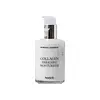What's inside
What's inside
 Key Ingredients
Key Ingredients

 Benefits
Benefits

 Concerns
Concerns

 Ingredients Side-by-side
Ingredients Side-by-side

Water
Skin ConditioningZinc Oxide
Cosmetic ColorantCyclopentasiloxane
EmollientCaprylic/Capric Triglyceride
MaskingGlycerin
HumectantIsodecyl Neopentanoate
EmollientCyclohexasiloxane
EmollientDiethylhexyl Carbonate
EmollientQuaternium-18 Bentonite
PEG-10 Dimethicone
Skin ConditioningButylene Glycol
HumectantNiacinamide
SmoothingBeeswax
Emulsion StabilisingSodium Chloride
MaskingSorbitan Sesquioleate
Emulsifying1,2-Hexanediol
Skin ConditioningVinyl Dimethicone/Methicone Silsesquioxane Crosspolymer
Portulaca Oleracea Extract
Skin ConditioningTriethoxycaprylylsilane
Dimethicone/Vinyl Dimethicone Crosspolymer
Skin ConditioningCaprylyl Glycol
EmollientChlorphenesin
AntimicrobialAdenosine
Skin ConditioningSimmondsia Chinensis Seed Oil
EmollientSqualane
EmollientStomach Extract
HumectantWater, Zinc Oxide, Cyclopentasiloxane, Caprylic/Capric Triglyceride, Glycerin, Isodecyl Neopentanoate, Cyclohexasiloxane, Diethylhexyl Carbonate, Quaternium-18 Bentonite, PEG-10 Dimethicone, Butylene Glycol, Niacinamide, Beeswax, Sodium Chloride, Sorbitan Sesquioleate, 1,2-Hexanediol, Vinyl Dimethicone/Methicone Silsesquioxane Crosspolymer, Portulaca Oleracea Extract, Triethoxycaprylylsilane, Dimethicone/Vinyl Dimethicone Crosspolymer, Caprylyl Glycol, Chlorphenesin, Adenosine, Simmondsia Chinensis Seed Oil, Squalane, Stomach Extract
Water
Skin ConditioningParaffinum Liquidum
EmollientButylene Glycol
HumectantTriethanolamine
BufferingCetearyl Alcohol
Emollient1,2-Hexanediol
Skin ConditioningStearic Acid
CleansingPalmitic Acid
EmollientMoringa Oleifera Seed Oil
EmollientCarbomer
Emulsion StabilisingGlyceryl Stearate
EmollientPEG-100 Stearate
Illicium Verum Fruit Extract
PerfumingGlycerin
HumectantOctyldodecanol
EmollientOleyl Alcohol
EmollientScutellaria Baicalensis Root Extract
AstringentButyrospermum Parkii Butter
Skin ConditioningHydrolyzed Soy Flour
Skin ConditioningCollagen Extract
Skin ConditioningCeramide NP
Skin ConditioningPhytosphingosine
Skin ConditioningHydrogenated Lecithin
EmulsifyingGlycine Soja Sterols
EmollientCandida Bombicola/Glucose/Methyl Rapeseedate Ferment
AntimicrobialTocopherol
AntioxidantBeta-Glucan
Skin ConditioningCentella Asiatica Extract
CleansingParfum
MaskingWater, Paraffinum Liquidum, Butylene Glycol, Triethanolamine, Cetearyl Alcohol, 1,2-Hexanediol, Stearic Acid, Palmitic Acid, Moringa Oleifera Seed Oil, Carbomer, Glyceryl Stearate, PEG-100 Stearate, Illicium Verum Fruit Extract, Glycerin, Octyldodecanol, Oleyl Alcohol, Scutellaria Baicalensis Root Extract, Butyrospermum Parkii Butter, Hydrolyzed Soy Flour, Collagen Extract, Ceramide NP, Phytosphingosine, Hydrogenated Lecithin, Glycine Soja Sterols, Candida Bombicola/Glucose/Methyl Rapeseedate Ferment, Tocopherol, Beta-Glucan, Centella Asiatica Extract, Parfum
Ingredients Explained
These ingredients are found in both products.
Ingredients higher up in an ingredient list are typically present in a larger amount.
1,2-Hexanediol is a synthetic liquid and another multi-functional powerhouse.
It is a:
- Humectant, drawing moisture into the skin
- Emollient, helping to soften skin
- Solvent, dispersing and stabilizing formulas
- Preservative booster, enhancing the antimicrobial activity of other preservatives
Butylene Glycol (or BG) is used within cosmetic products for a few different reasons:
Overall, Butylene Glycol is a safe and well-rounded ingredient that works well with other ingredients.
Though this ingredient works well with most skin types, some people with sensitive skin may experience a reaction such as allergic rashes, closed comedones, or itchiness.
Learn more about Butylene GlycolGlycerin is already naturally found in your skin. It helps moisturize and protect your skin.
A study from 2016 found glycerin to be more effective as a humectant than AHAs and hyaluronic acid.
As a humectant, it helps the skin stay hydrated by pulling moisture to your skin. The low molecular weight of glycerin allows it to pull moisture into the deeper layers of your skin.
Hydrated skin improves your skin barrier; Your skin barrier helps protect against irritants and bacteria.
Glycerin has also been found to have antimicrobial and antiviral properties. Due to these properties, glycerin is often used in wound and burn treatments.
In cosmetics, glycerin is usually derived from plants such as soybean or palm. However, it can also be sourced from animals, such as tallow or animal fat.
This ingredient is organic, colorless, odorless, and non-toxic.
Glycerin is the name for this ingredient in American English. British English uses Glycerol/Glycerine.
Learn more about GlycerinWater. It's the most common cosmetic ingredient of all. You'll usually see it at the top of ingredient lists, meaning that it makes up the largest part of the product.
So why is it so popular? Water most often acts as a solvent - this means that it helps dissolve other ingredients into the formulation.
You'll also recognize water as that liquid we all need to stay alive. If you see this, drink a glass of water. Stay hydrated!
Learn more about Water